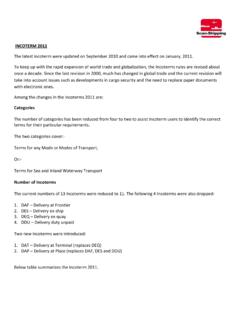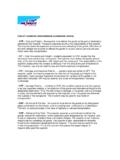Transcription of Incoterms® Rules Q&A ICC general guidance on selected ...
1 1 incoterms Rules Q&A ICC general guidance on selected questions on the incoterms 2010 Rules ( ) September 2011 INTRODUCTION As the publisher of the new incoterms 2010 Rules for the use of domestic and international trade terms, the International Chamber of Commerce (ICC) is committed to serving its members and the broader international trading community by offering general guidance on some questions that have arisen in connection with the release of the new incoterms 2010 Rules . The views expressed below are intended as general interpretive guidance only, and not as authoritative opinion. Each case differs depending on place, parties, industry, applicable laws and relevant customs and usages, so general guidance cannot be expected to determine an outcome in a dispute. Readers are encouraged to supplement their learning on the Rules by consulting the ICC publications, incoterms 2010 and the ICC Guide to incoterms 2010.
2 QUESTIONS 1. Letters of credit citing incoterms 2010 with the circled R trademark indicator may cause unintended discrepancies for beneficiaries unable to do likewise in their documents (as with typewriters). The absence of the trademark symbol in a citation to any version of the incoterms Rules , including incoterms 2010, should not render a document discrepant with a letter of credit that includes the trademark symbol in its citation to the incoterms Rules . 2. Who pays for THC (terminal handling charges) under the new incoterms 2010 Rules ? Allocation of costs as between buyer and seller under the Rules are set out in articles A6/B6, which in the new Rules have been made clearer and in some cases clarify the relation between the contract of sale and the contract of carriage. Terminal handling charges is a broad category and each charge being considered needs to be analyzed to see whether it occurred before or after delivery under article A4 of the relevant incoterms rule, and whether it relates to an obligation treated particularly in the 2 Rules , as, for example, an import or export clearance charge, obligations with respect to which are set out in articles A2/B2.
3 3. There are questions regarding who bears costs for security-charges (A2/B2 and A10/B10) under the incoterms 2010 Rules . Since 1 January 2011 , for example, all incoming deliveries into the [European] Common Market are subject to an ENS-filing to be done 24 hours before loading the ship. We observe that carriers are dealing with this issue differently in terms of payment. Since there are a great number of legal reporting regulations ( in the field of hazardous materials, veterinarian, port authorities), these costs are in some cases being added to the usual sea freight and the fees are being invoiced in accordance with sea freight (either prepaid or collect). Other carriers (mainly Asian) are treating the ENS fees as purely prepaid costs to be covered by the shipper. Independent of this example, different points of view to this question are being represented in practice, such as how to account the current security fees and whether they should or should not be treated as import or export formalities.
4 While the incoterms Rules are clauses to be used in sales contracts, within shipping company and freight contracts, they are treated as francatur-clauses with the result that the carrier making reference to incoterms clauses in contracts for carriage charge the costs either to the seller (shipper) or the buyer (consignee). Therefore, in our opinion it is very important that clear statements should be made. We think it necessary that a common use in practice should be determined and would be grateful if you could answer some of our questions: Who should according to the incoterms 2010 Rules bear the costs for safety precautions for transport of goods? Should this always be the buyer? Have you heard of similar issues within other economic sectors? At the time of preparing incoterms 2010 the drafting group reviewed the various cargo security arrangements around the world. It became evident that although cargo security is a much more important issue than it was in 2000 there was no consistent global practice.
5 With no consistent global practice the drafting group was reluctant to impose change. Therefore articles A2/B2 and A10/B10 were changed but only to a limited extent. The allocation of costs for security will vary between seller and buyer depending on the incoterms rule chosen for example DAT will be different to FCA. Note the incoterms Rules relate to the sale of goods contract between buyer and seller, and NOT to the relationship with the carrier. 3 Under FCA then (assuming delivery point is not the seller s premises): The seller is responsible for clearing export but not import formalities. Therefore a seller in Japan is not responsible for an ENS filing as that is required for import. However, under A10/B10 the seller must provide the buyer with documents or information required by the buyer to complete the ENS filing at the buyer s risk and expense. Where there are safety precautions required for transport after the delivery point then they are for the buyer to deal with UNLESS it is a mandatory requirement to allow the goods to be exported (but note seller must in any event appropriately package the goods under article A9).
6 The seller is responsible under A10 to provide information and data. For example DAP (buyer s premises Paris) where seller is based outside the European Community (EC) and the first point of import into the EC is in France then: The ENS filing is an import requirement for the EC. Under DAP the seller is not responsible for clearing import requirements. Therefore if the seller is based outside of the EC the seller is not responsible for ensuring the ENS filing is completed. However the ENS filing is completed by the ocean carrier. In this example the seller will have contracted with the ocean carrier as the seller is responsible for transportation to the Paris destination. Therefore the carriage contract will require the seller to provide the information needed for the ENS filing and the carrier may charge the seller for fulfilling it. The buyer is obliged to provide the information needed for the seller to provide to the ocean carrier for the ENS filing.
7 This is because the buyer is obliged to clear import requirements under B2. As ENS filing is an import obligation then the buyer is obliged to reimburse the seller for ENS filing cost. 4. A seller under one of the incoterms 2010 Rules in the F-family (FCA, FAS or FOB) delivers goods in seller s own country, but the goods are destined post-delivery for another country. The buyer arranges and pays for carriage and risk for the goods has already passed to buyer at delivery in seller s country. It is not clear from the language of the incoterms 2010 Rules that in such a situation export clearance is applicable for the seller under aricle A2. If it is applicable , why? If not, then isn t the requirement on the seller even lower than under article A2 in EXW, 4 where seller is required at least to provide assistance to the buyer for export of the goods? If the goods are destined for another country then export clearance is applicable and the seller needs to do it.
8 The words "where applicable" are used to denote that incoterms 2010 can be used in an entirely domestic setting as well. In EXW, the seller only needs to provide assistance for export clearance but is not responsible for it. 5. What is included in seller s premises under FCA article A4(a)? Seller s premises may be any place under the seller s control. In many cases, sellers consider a terminal contracted by the seller to be seller s premises, in which case, seller would be obliged to load the goods on the buyer s transport ( ship) and therefore the seller would be responsible for the terminal handling and loading costs. Therefore if it is not obvious whether or not the place of delivery is the seller s premises , then it should be made clear in the contract of sale to avoid a dispute. 6. What is included in seller s means of transport under FCA article A4(b)? It may be a carrier contracted for by the seller.
9 It need not literally be the seller s own vehicle. 7. The guidance Notes to CPT and CIP say that the default position is that risk passes when the goods have been delivered to the first carrier . Who is the first carrier ? The first carrier is the very first carrier independent of the seller ( , not the seller's own vehicle/vessel) with whom the seller has contracted for carriage. 8. Under incoterms 2010 Rules CPT, CIP, CFR and CIF, the seller must contract on usual terms at its own expense for the carriage of the goods to the named place or port of destination. After delivery at the place or port of departure, the buyer bears all risks for the goods (article B5) and must pay all costs and charges relating to the goods while in transit until their arrival at the place or port of destination, unless such costs and charges were for the seller s account under the contract of carriage (article B6(b)).
10 What costs would realistically arise during transit not related to the freight being paid by seller? It seems these would arise only in extraordinary cases. Would buyer have to pay for things like increase of rates, charges connected with extra deviation, or change of rotation? 5 Under article A6(b) of the C-terms, seller must pay for freight and other costs relating to obtaining a contract of carriage. In any case, if the freight-included pricing of the goods offered by the seller is accepted by the buyer and the sale contract is enacted between the parties on such terms, then the seller should bear any subsequent increases in the freight tariffs. In the sense of article B6 under C-terms, the transfer of risk also determines the division of costs. If something occurs as result of contingencies after shipment, such as stranding, collision, strikes, governmental commands, or bad weather conditions, any other unanticipated costs charged by the carrier as a result of these contingencies, the mentioned unanticipated costs will be for the account of the buyer (unless specified as for the seller s account in the contract of carriage).






